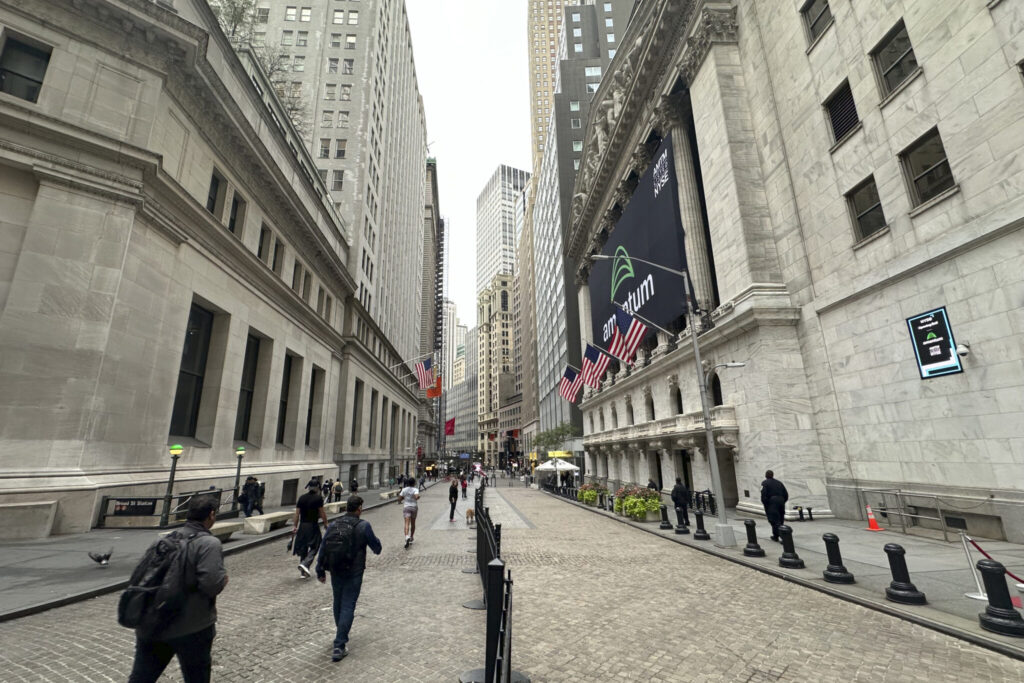Wall Street/ U.S. labor market/ Federal Reserve/ stock market dip/ inflation/ dockworkers strike/ Newslooks/ NEW YORK/ J. Mansour/ Morning Edition/ Wall Street edged lower on Tuesday as investors anticipate key labor market data that could influence future Federal Reserve decisions. The Fed’s focus has shifted to employment figures, with job openings data due Tuesday and jobless claims on Thursday. Meanwhile, a dockworkers strike and European inflation are also shaping market sentiment.

Labor Data Impact on Markets Quick Looks
- Market Movement: The S&P 500 futures dipped 0.1%, and Dow Jones futures fell 0.2%.
- Upcoming Data: Job openings data on Tuesday, with the U.S. monthly jobs report on Friday.
- Federal Reserve Focus: The Fed’s next moves hinge on the labor market after cutting interest rates to combat inflation.
- Dockworkers Strike: Ongoing strike at U.S. ports may disrupt supply chains, though immediate impact is minimal.
- Global Markets: European inflation dropped, Japanese manufacturing outlook steady, and China markets closed for holidays.
Wall Street Slips as Labor Data Awaits Fed’s Decision
Deep Look
Wall Street opened quietly lower on Tuesday as investors await critical labor market data that could heavily influence the Federal Reserve’s strategy for maintaining U.S. economic stability. After a period of record-breaking highs for the markets, including the S&P 500, attention has shifted toward the upcoming employment reports, which may determine the Fed’s next steps in its interest rate policy.
Early trading showed slight declines, with futures for the S&P 500 down by less than 0.1%, and the Dow Jones Industrial Average dipping by 0.2%. Wall Street has been riding a wave of optimism, driven by the hope that the U.S. economy can continue to expand despite signs of slowing growth. The potential for further interest rate cuts by the Fed has fueled these expectations, and Friday’s release of the U.S. government’s monthly jobs update will provide a crucial test for the market’s current sentiment.
In the more immediate term, markets are also awaiting Tuesday’s job openings report, followed by the weekly jobless claims update set to be released on Thursday. These reports are seen as significant indicators of labor market health, which the Federal Reserve has been closely watching as inflation appears to have been largely brought under control.
Since 2022, the Federal Reserve has raised interest rates multiple times in an attempt to rein in inflation, which persisted longer than initially anticipated. Recently, the Fed has shifted gears, cutting its benchmark lending rate in an effort to engineer what’s known as a “soft landing” — cooling the economy just enough to tame inflation without pushing it into a recession. Two weeks ago, the central bank surprised many by implementing a larger-than-expected half-point rate cut. However, Fed Chair Jerome Powell has made it clear that future cuts will come at a more cautious pace.
Meanwhile, investors are also keeping a close eye on a strike by dockworkers that began early Tuesday at 36 ports stretching from Maine to Texas. The walkout, involving approximately 45,000 workers, is centered around wage negotiations and concerns about automation. While the immediate effects on supply chains are expected to be limited, as many retailers have already stocked up on goods for the holiday season, a prolonged strike could result in shortages and rising prices in the weeks to come.
Beyond the U.S., global markets were relatively stable, with European markets showing some positive movement. Notably, inflation in the eurozone dropped to 1.8% in September, the lowest level in more than three years and below the European Central Bank’s target of 2%. This decline in inflation, combined with Europe’s sluggish growth prospects, may pave the way for faster rate cuts from the ECB, which has already reduced rates twice this year. In midday trading, France’s CAC 40 remained flat, while Germany’s DAX rose 0.4%, and London’s FTSE 100 gained 0.5%.
In Asia, Japan’s Nikkei 225 saw a robust 1.9% increase, closing at 38,651.97. The gains were driven in part by a weaker yen and a steady business confidence report from the Bank of Japan’s quarterly “tankan” survey. The survey’s index of business sentiment among large manufacturers held steady at 13, signaling an improved outlook. Additionally, Japan’s unemployment rate fell to 2.5% in August, down from 2.7% in July, matching market expectations.
Elsewhere in the region, Australia’s S&P/ASX 200 dropped 0.7%, despite data showing a 3.1% increase in retail sales for August compared to the same month last year, beating expectations. Chinese and South Korean markets remained closed for holidays, with China’s mainland markets closed until October 7 for the National Day holiday. On Monday, Chinese stocks had their best day since 2008, underscoring the ongoing strength of the country’s market despite external challenges.
In commodity markets, U.S. crude oil prices fell by 50 cents to $67.67 per barrel, while Brent crude, the international benchmark, dropped 42 cents to $71.28 per barrel. In currency markets, the euro slipped to $1.1085, down from $1.1138.
Monday’s trading session saw the S&P 500 climb 0.4% to set an all-time high of 5,762.48, marking its fifth consecutive monthly gain and its fourth straight winning quarter. The Dow Jones Industrial Average eked out a gain of less than 0.1%, closing at 42,330.15, while the Nasdaq composite rose by 0.4%, finishing at 18,189.17.







